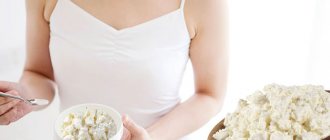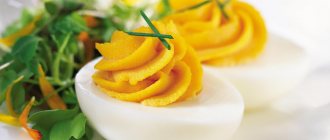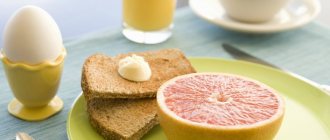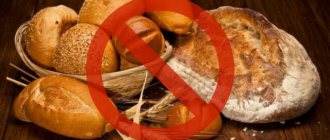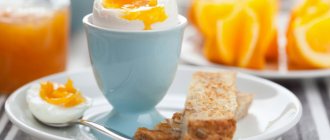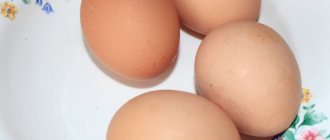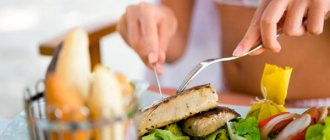This is interesting
The principle of the Maggi diet for 14 days is based on the fact that high protein foods have a low glycemic index (GI). In simple terms, this means that foods with a lower GI provide long-lasting satiety, while at the same time suppressing sugar cravings. According to a recent study by the American Society for Clinical Nutrition, increased protein intake suppresses appetite.
The original Maggi diet menu for 2 weeks is based on hard-boiled eggs. Its main rule is the distribution of food and regularity of nutrition. It is also necessary to maintain a drinking regime. And, since there is no effective weight loss without movement, physical activity is the most important part of dieting. An important principle of the Maggi food scheme for 2 weeks is a significant reduction in calorie intake (about 4000 kJ, and sometimes less).
Reviews about the diet
On any resource about diets and weight loss, by opening the page “ Maggi diet reviews ”, you can find a huge number of enthusiastic comments and reviews about this diet: “magic weight loss”, “effective diet”, “really lose weight”...
Women of all ages share their impressions: one lost 16 kilograms in 4 weeks, another managed to lose 9 extra kilos, the third is glad that her belly was cleared after childbirth.
The most interesting fact is that none of the Maggi dieters complained that they had to endure the feeling of hunger.
| Curd version of the Maggi diet |
Acceptable and prohibited foods: their energy value
The Maggi diet menu can help you lose weight, reduce fat, and increase blood lipid levels. It helps people control their tastes. The recommended daily intake of protein is 0.8 g/kg body weight, but when losing weight, protein intake should be increased to 1.2-1.4 g/kg with fewer calories from fats and carbohydrates.
Unlike longer-term protein-based diets, Maggi does not have time to enter a state of ketosis when it consumes energy instead of carbohydrates from ketones produced when burning fat.
In contrast to the original Maggi diet for 2 weeks, the menu of the modern version contains, in addition to eggs, other sources of proteins.
Maggi diet with eggs in the original:
Authorized products:
- cheese;
- fish;
- milk and dairy products;
- eggs;
- soy;
- meat;
- vegetables;
- some fruits;
- sometimes nuts and seeds;
- clean and lemon water.
Prohibited products:
- cereals;
- potato;
- pasta;
- bread;
- sweets;
- flavored and sweet drinks;
- alcohol;
- some fruits;
- white sugar.
Table of recommended foods on the Maggi diet (menu for breakfast, lunch, dinner) and the number of calories for one day:
| Breakfast | Quantity, g | kJ | Protein, g | Carbohydrates, g | Fats, g | Cholesterol, mg |
| Grapefruit | 50 | 86 | 0,25 | 4,80 | 0,15 | 0 |
| Eggs | 150 | 1083 | 19,80 | 0,90 | 19,80 | 870 |
| Coffee (without sugar, milk) | 200 ml | 0 | 0 | 0 | 0 | 0 |
| Dinner | Quantity, g | kJ | Protein, g | Carbohydrates, g | Fats, g | Cholesterol, mg |
| Eggs | 150 | 1083 | 19,80 | 0,90 | 19,80 | 870 |
| Tomatoes | 100 | 103 | 1,10 | 4,60 | 0,30 | 0 |
| Coffee (without sugar, milk) | 200 ml | 0 | 0 | 0 | 0 | 0 |
| Dinner | Quantity, g | kJ | Protein, g | Carbohydrates, g | Fats, g | Cholesterol, mg |
| Chicken breast | 100 | 366 | 18,90 | 0,30 | 1,00 | 50 |
| Salad | 100 | 53 | 0,70 | 1,90 | 0,30 | 0 |
| Total values | 2774 | 60,55 | 13,40 | 41,35 | 1790 | |
| Recommended values | 8500 –11000 | 65 – 80 | 308 – 386 | 60 – 85 | 300 |
The values show that the amount of energy consumed is significantly reduced, the level of carbohydrates does not contain even 1/10 of the recommended daily dose, protein and fat are normal, and cholesterol is extremely high.
Drinking regime
If you decide to follow the Maggi diet for 2 weeks, the menu table of which is presented above, do not forget about the drinking regime - it is important to avoid dehydration. Avoid mineral waters and alcohol.
Drink unsweetened drinks. The best choice is plain still water, herbal or fruit tea. Coffee is also recommended, but without sugar and milk.
The diet is not recommended for pregnant women, nursing mothers, children under 18 years of age, and the elderly.
Menu for 4 weeks
During the first two weeks, the method involves taking 1/2 grapefruit or orange, as well as 1-2 boiled eggs, for breakfast every day.

Week #1
1 day:
- lunch - fruits in any quantity: apples, pears, oranges, watermelon, melon, etc. (except for those prohibited);
- dinner – baked chicken (can also be fried) – 250 g.
Day 2:
- lunch – baked or boiled chicken breast without skin (200 g);
- dinner - 2 boiled eggs, salad (tomatoes + lettuce + cucumbers + carrots + peppers - 150 g), ¼ flatbread or 1 toast (25 g), 1 grapefruit or orange.
Day 3:
- lunch – low-fat cheese in any quantity, 2 tomatoes, 1 toast (25 g);
- dinner – 250 g of any boiled or baked meat.
Day 4:
- lunch - any fruit in any quantity, except for prohibited ones;
- dinner - 250 g of boiled or baked chicken, salad (tomatoes + lettuce + cucumbers + carrots + peppers - 150 g).
Day 5:
- lunch – 2 boiled eggs, boiled vegetables of your choice: zucchini, carrots, green peas, beans (250 g);
- dinner - 200 g of boiled shrimp, salad (tomatoes + lettuce + cucumbers + carrots + peppers - 200 g), 1 grapefruit or orange.
Day 6:
- lunch – one any fruit in any quantity;
- dinner – boiled or baked chicken (can also be fried) – 200 g.
Day 7:
- lunch – baked or boiled skinless chicken (250 g), boiled vegetables (200 g), 1 tomato, 1 grapefruit or orange;
- dinner - boiled vegetables of your choice, except forbidden ones (200 g).
Week #2
1 day:
- lunch – boiled or baked (fried) meat (250 g), salad (tomatoes + lettuce + cucumbers + carrots + peppers – 200 g);
- dinner – 2 boiled eggs, 1 grapefruit or 1 orange.
Day 2:
- lunch – boiled or baked meat (200 g), salad (tomatoes + lettuce + cucumbers + carrots + peppers – 200 g);
- dinner – 2 boiled eggs, 1 grapefruit or orange.
Day 3:
- lunch – boiled or baked (fried) meat (200 g), cucumbers (as much as you want);
- dinner – 2 boiled eggs, 1 grapefruit or orange.
Day 4:
- lunch – 2 boiled eggs, any low-fat white cheese (150 g), boiled vegetables from the permitted ones (150 g);
- dinner – 2 boiled eggs.
Day 5:
- lunch – 200 g of baked or boiled fish/boiled shrimp (fried fish is also allowed);
- dinner – 2 boiled eggs.
Day 6:
- lunch – 200 g of baked or boiled meat (can be fried), 2 tomatoes, 1 grapefruit or orange;
- dinner - fresh fruits (except forbidden ones) - as much as you want.
Day 7:
- lunch – fried, baked or boiled skinless chicken (200 g), 3 tomatoes, boiled vegetables (150 g), 1 grapefruit or orange;
- dinner - fried or boiled skinless chicken (150 g), 2 tomatoes, boiled vegetables (150 g), 1 grapefruit or orange.
Week #3
The weekly diet includes plenty of vegetables and fruits, which should be eaten throughout the day.
1 day:
- any fruit in any quantity, except banana, dates, mangoes, figs and grapes.
Day 2:
- any salads and boiled vegetables, with the exception of potatoes and dry cereals - as much as you want.
Day 3:
- any fruits and vegetables (except prohibited ones), salads in any quantity and at any time.
Day 4:
- baked or boiled fish (200 g), salad (Chinese cabbage + fresh cucumber - 100 g), boiled vegetables (any in any quantity).
Day 5:
- 200 g of lean boiled or fried meat, 200 g of boiled vegetables.
Day 6:
- 1 type of fruit in any quantity (except prohibited ones).
Day 7:
- 1 type of fruit in any quantity.
Week #4
Products from the diet should be consumed throughout the day and at any time, but without additions.
1 day:
- 250 g boiled chicken breast;
- 4 cucumbers and 3 tomatoes;
- 150 g tuna without oil;
- one toast (25 g);
- 1 grapefruit or orange.
Day 2:
- no more than 200 g of baked or boiled meat;
- 4 cucumbers and 3 tomatoes;
- 1 toast (25 g);
- choice: 1 apple, or 1 orange, or 1 pear, or 1 grapefruit, or 1 slice of melon.
Day 3:
- 1 tablespoon of cottage cheese or any low-fat white cheese (150 g);
- 150 g boiled vegetables;
- 2 tomatoes and 2 cucumbers;
- one toast (25 g);
- 1 orange or 1 grapefruit.
Day 4:
- 1/2 boiled or baked chicken;
- 1 cucumber and 3 tomatoes;
- 1 orange or 1 grapefruit.
Day 5:
- 2 boiled chicken eggs;
- 3 tomatoes, 1 lettuce leaf;
- 1 grapefruit or orange.
Day 6:
- 250 g boiled chicken breast;
- 125 g feta cheese or cottage cheese;
- 1 toast (25 g), 2 tomatoes, 2 cucumbers;
- yogurt (150 ml), 1 grapefruit or 1 orange.
Day 7:
- 1 tablespoon of cottage cheese, 1 can of tuna without oil (150 g);
- 150 g boiled vegetables;
- 2 tomatoes, 2 cucumbers;
- 1 toast (25 g), 1 grapefruit or 1 orange.
Please note that adding salt to food is allowed. You can also add onion, garlic and sugar-free soy sauce. However, it is prohibited to use seasonings that contain flavor enhancers: monosodium glutamate (E621), sodium inosinate (E631) and sodium guanylate (E627).
For 2 additional weeks
If you have successfully completed the Maggi course and want to repeat it, start from the first week, and then go straight to the fourth.
This diet is suitable for people of any age. However, before you start, you should definitely consult your doctor.
Indications and contraindications
The Maggi menu for 2 weeks is intended for healthy overweight and obese people. It is also suitable for those who want to adapt their diet and lifestyle to healthy standards. But this requires a lot of patience and endurance.
Contraindications:
- pregnancy;
- lactation;
- diabetes;
- childhood;
- severe mental illness, especially from a number of eating disorders (mental anorexia);
- diseases of the liver, kidneys, heart;
- disorders of mineral metabolism;
- bleeding disorders (including in patients taking Warfarin);
- gallstones;
- metabolic disorders (eg, phenylketonuria, gout, etc.);
- allergy to dietary components.
Some of these groups of people can successfully follow the Maggi diet, but only on the recommendation and under the supervision of a doctor or nutritionist.
Pros and cons of this nutrition principle
Advantages:
- plenty of complete protein;
- saturation;
- rapid weight loss;
- regular meals;
- healthy food;
- reducing the amount of white sugar and alcohol.
Flaws:
- craving for sweets;
- monotonous menu;
- lack of fiber;
- lack of certain vitamins and minerals;
- risk of cardiovascular disease, kidney disease with longer adherence;
- unbalanced diet;
- risk of developing gout;
- increased risk of colon cancer with saturated fat intake;
- risk of dehydration;
- possible yo-yo effect.
Facts and myths
Today there is a lot of information and recommendations available regarding weight loss, most of which are not based on truth. How to figure this out?
Myth: White wine promotes weight loss
Alcohol while losing weight is not recommended. As a last resort, 200 ml of white wine is allowed, washed down with the same amount of water to prevent dehydration.
Myth: When losing weight, you can consume sweets for diabetics
Products labeled “dia” contain almost the same amount of energy as regular sweets, and only due to their composition they are more suitable for diabetics.
Myth: It is recommended to drink water before every meal.
Drinking a glass of water before eating can actually help flush out toxic substances and make your food easier to digest, but be careful! Large amounts of water during meals are not recommended because they slow down digestion.
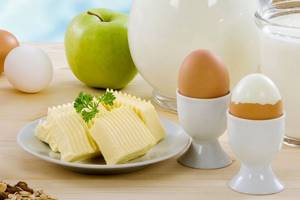
Adviсe
Stick strictly to the permitted types of food, and do not expand your diet according to personal preferences. Don't exclude protein foods, even if you feel full. Losing weight is achieved through protein consumption.
If you feel hungry, despite following the menu, it is permissible to take an additional portion of permitted vegetables at any time during the day.
Don't forget about physical activity (at least 1 hour 3 times a week). This will support metabolism, speed up the weight loss process, and strengthen muscles.
Products
When using the Maggi weight loss system, you need to pay attention to eating the same foods for 2 or 4 weeks. The menu contains different dishes, but without much variety of ingredients.
The developers of the diet created a special indicative table indicating permitted and prohibited foods .
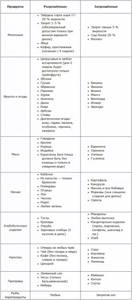
Many sweet, flour, salty and fried foods are prohibited. Cereals - rice, buckwheat - are also excluded. Citrus fruits are recommended among fruits, as they contain fat-burning acids.
All food products must be cooked. The following cooking methods are used to lose weight:
- Steaming.
- Cooking in a saucepan.
- Baking in the oven or oven.
There is no need to use oil when cooking. A small amount is allowed after 4 weeks of fasting.
After leaving the diet, frying meat in a frying pan is allowed, subject to the following rules (to avoid rapid weight gain):
- eat small portions;
- use this method no more than once every 3 days;
- use a non-stick frying pan.
Point of view
Reviews about the Maggi diet for 2 weeks cannot be called negative. People who have followed this food regimen testify to its effectiveness (except for people who did not consult a doctor before changing their diet). Is the opinion of experts equally positive?
The effectiveness of the Maggi diet has been tested on yourself - minus 5 kg. But after eating this way, eggs disappeared from my diet...
Faith
Minus 5 kg in 2 weeks. The activity of the stomach has normalized.
Inna
While following the Maggi diet, cholecystitis began for two weeks. I switched to the cottage cheese version.
Mila
The main indicator of a suitable diet is good health. If a change in diet does not cause discomfort, it means that the body accepts it. But in case of negative reactions of the body (nausea, dizziness, etc.) there is no need to torture it.
V. Kononova, nutritionist
How to consolidate results
If you follow the Maggi diet menu for two weeks, you can lose up to 5-7 kg, but this figure is individual. To prevent the yo-yo effect after finishing your diet plan, continue following the principles of healthy eating.
The essence of the weight loss technique
There is an opinion that the Maggi diet was developed by nutritionists from the USA specifically for the “iron” lady Margaret Thatcher. Among her papers in 1979, a diary was found with a piece of paper enclosed in it, on which a menu was written based on the consumption of a large number of eggs. This technique became the basis of the current diet, which has undergone some changes over the years.

It is believed that the Maggi diet was developed specifically for Margaret Thatcher
The Maggi diet is not based on fasting, but on the biochemical processes that occur in the body under a certain diet . This method of losing weight involves consuming a large amount of protein foods, while the intake of carbohydrates and fats is practically reduced to zero.
Health benefits of stewed cabbage:
It is known that carbohydrates are a source of energy. When they are deficient, the body begins to replenish the energy deficit using glycogen. This substance is a kind of storage form for excess glucose. Glycogen accumulates in the liver, muscles and fat cells. During the first 2-3 days of the diet, the body uses all glycogen reserves, and then begins to break down fat deposits, obtaining ketones in this process - new sources of energy. By reducing the fat layer, weight loss occurs.
The Maggi diet allows you to lose 8–12 kg of excess weight in 2 weeks (the higher your initial body weight, the more kilograms you can lose).
Protein sources
This weight loss technique refers to protein diets. The main sources of protein during the Maggi diet are eggs and cottage cheese. Why were these particular products taken?
Egg white is accepted among experts as the standard against which other proteins are compared, since it is 98% digestible. When consuming the product, the body receives many vitamins (A, E, D, K, group B), minerals (iron, phosphorus, copper, iodine, calcium, potassium) and other biologically active components. Eggs satisfy the feeling of hunger for a long time, while their calorie content is only 157 kcal per 100 g .
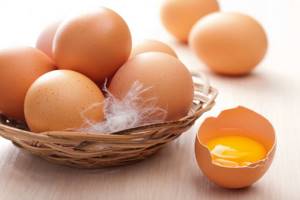
Chicken eggs contain essential amino acids
Another version of the diet uses cottage cheese, which contains many nutritious proteins (for example, casein). In addition, the product contains the essential amino acid methionine, which promotes the effective breakdown of fats and prevents the accumulation of fatty deposits in the liver. Methionine is not synthesized in the body, so it must be supplied with food.
Cottage cheese also contains vitamins (A, B1, B2, PP, K) and minerals (calcium, sodium, magnesium, phosphorus, iron). The product is well absorbed and has virtually no contraindications. The calorie content of cottage cheese is 110 kcal per 100 g.
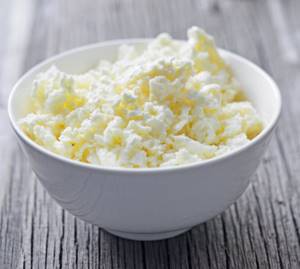
Cottage cheese contains valuable protein casein
14-day menu
The Maggi diet menu for 2 weeks has the main product - eggs. Breakfasts are the same for 14 days, consisting of 3 hard-boiled eggs, ½ grapefruit, coffee without sugar and milk.
| Day | Dinner | Dinner |
| Mon. | 3 eggs, tomato, coffee | 3 eggs, lemon salad (no oil) |
| Tue | ½ grapefruit, 2 eggs, coffee | Boiled beef, lettuce, tomato |
| Wed. | 1-3 eggs, 200 g spinach, tomato, lemon water | Baked fish, salad, whole grain bread |
| Thurs. | 1-2 eggs, vegetable salad, coffee | Boiled veal or lamb, tomatoes, celery, tea |
| Fri. | Vegetable salad | Boiled beef, celery |
| Sat. | Vegetable salad | Boiled beef, celery |
| Sun. | ½ grapefruit, ¼ grilled chicken, tomato | ½ grapefruit, ¼ grilled chicken, tomato, celery, carrots |
The menu for the second week is repeated.
Rules for following the Maggi Diet
1. Any snacks are prohibited in the first 2 weeks;
2. Drink 2 liters of water per day;
3. Do not achieve the feeling of overeating. This is especially dangerous in the third week, when you are allowed to eat as much as you want. It is better to finish each meal with a feeling of slight (!) hunger;
4. It is necessary to limit salt;
5. Every day be in the fresh air for 30 minutes or more;
6. Walking is necessary for at least an hour a day, or, alternatively, cycling;
7. You need to have dinner at least 3-4 hours before bedtime;
8. Any active activities or sports are necessary;
9. Taking medications should be minimized;
10. Provide the body with a gradual exit from the Maggi diet: carbohydrates and fats after 4 weeks of protein fasting should be gradually included in the diet in small portions. Then the result will last for a long time.
One day menu
Based on the one-day menu, you can create a more balanced diet that is acceptable for the modern variation of the Maggi dietary pattern.
Example #1:
- Breakfast: 3 eggs, ½ grapefruit, coffee.
- Lunch: 3 eggs, spinach, tomato, lemon water.
- Dinner: fried fish, whole grain bread, salad.
Example #2:
- Breakfast: whole grain bread, mozzarella, pepper.
- Afternoon snack No. 1: apple.
- Lunch: beef steak, vegetable side dish.
- Afternoon snack No. 2: low-fat yogurt.
- Dinner: 2 eggs, a glass of milk.
Example #3:
- Breakfast: low-fat cottage cheese with nuts, a spoonful of honey.
- Afternoon snack No. 1: apple.
- Lunch: pasta with stewed corn, sprinkled with cottage cheese.
- Afternoon snack No. 2: egg with a spoonful of cottage cheese, cucumber.
- Dinner: fried root vegetables with low-fat cottage cheese.
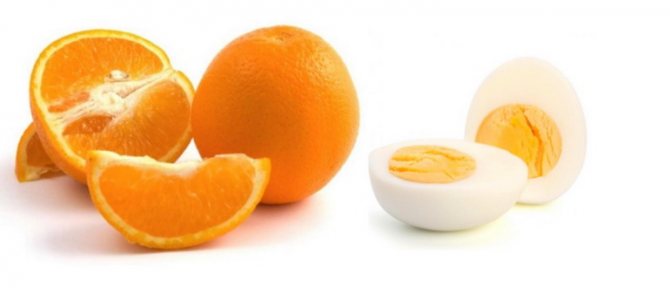
Smooth exit from the diet
The finish line must be completed without eating fatty, sweet or starchy foods. The intake should be varied and contain a small amount of calories. In 7 days you can eat only 2 or 3 eggs. It is recommended to reduce the quantity of citrus fruits or completely eliminate them for a certain period of time. You can replace them with 2-3 large spoons of honey.
It is allowed to add a little granulated sugar to a coffee drink or tea. Vegetables can be eaten as usual. The body should not receive protein for more than 4 weeks. This is bad for weight loss. You also need to constantly check your health. If you are in a bad mood and have unpleasant feelings, you need to change your diet.
Recipes
Following the Maggi diet, especially its modern interpretation, is not without tasty dishes. Try the following recipes.
Celery and ginger soup
Prepare:
- onion – 1 pc.;
- lemon – 1 pc.;
- pepper - a pinch;
- parsley - a sprig;
- olive oil – 1 tbsp;
- salt - a pinch;
- ginger – 1 pc.;
- vegetable broth (from carrots, broccoli and other vegetables) – 1 l;
- celery – 1 pc.
Fry the onion in oil, add finely chopped ginger, and lightly fry again. Add chopped celery, stir, pour in vegetable broth. Cook for 20-30 minutes. Season with salt and pepper.
Spicy chicken on cabbage
Prepare:
- garlic – 2 cloves;
- onion – 1 pc.;
- chopped bay leaf - a pinch;
- chicken thigh – 2 pcs.;
- sauerkraut – 200 g;
- sour cream – 8 tbsp;
- ground sweet pepper;
- olive oil – 1 tbsp.
Peel and chop the onion and garlic. Grease a baking sheet with oil, lay out the squeezed cabbage, add a bay leaf, sprinkle with chopped garlic, ground bell pepper, chopped onion, and pour in sour cream. Top with salted chicken thighs. Cover the baking sheet with baking paper and bake in a preheated oven. Add water if necessary. After half an hour, remove the paper and continue baking until golden brown.
